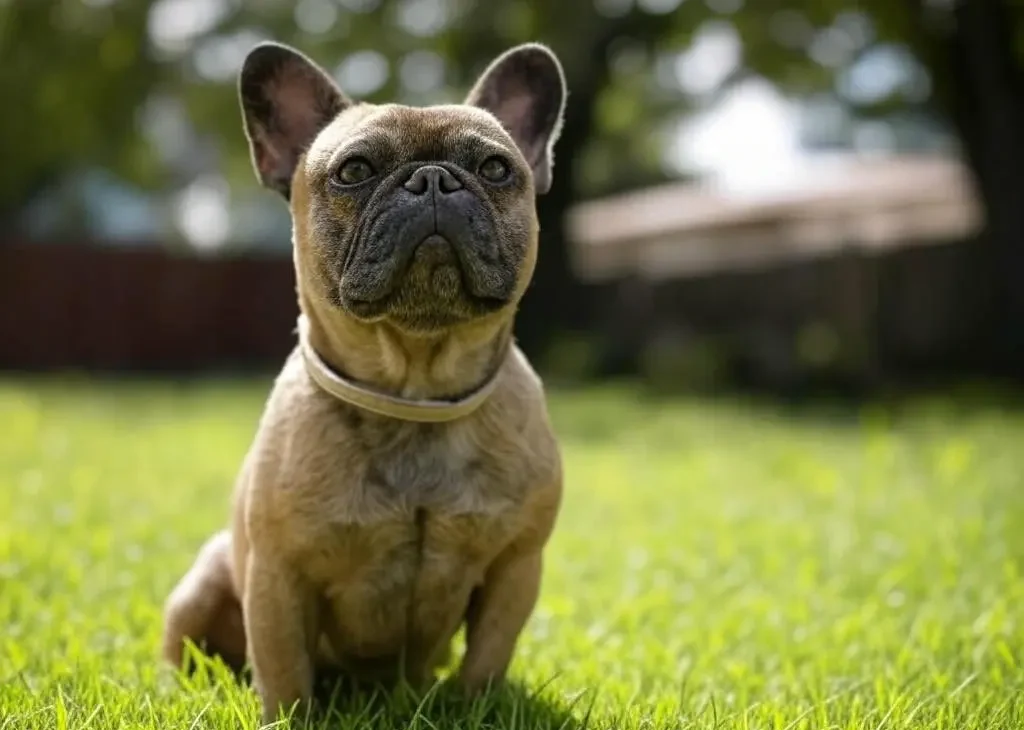Effective French Bulldog training requires understanding their unique temperament and using methods tailored to their distinct personality. These adorable companions are intelligent but can be stubborn, making proper training techniques essential for a well-behaved and happy Frenchie. This comprehensive guide covers everything from basic obedience to advanced methods for addressing common behavioral challenges.
As a certified canine behaviorist with over 12 years specializing in brachycephalic breeds, I’ve developed training programs specifically for French Bulldogs and their owners. French Bulldog training presents unique challenges and rewards that differ from working with other breeds. Their combination of intelligence, sensitivity, and occasional stubbornness requires specialized approaches that honor their distinctive temperament while achieving reliable results.
In this complete guide to French Bulldog training, you’ll discover proven techniques that work specifically for Frenchies, practical solutions to common training challenges, and step-by-step methods to develop a well-mannered companion. Whether you’re starting with a new puppy or working with an adult dog, these expert strategies will help you build a strong foundation for a lifetime of good behavior.
Understanding French Bulldog Behavior
Successful French Bulldog training begins with understanding the breed’s natural tendencies and behavioral patterns. Recognizing their inherent traits helps you set realistic expectations and tailor your approach for maximum effectiveness.
Common Behavioral Traits of French Bulldogs
French Bulldogs display several distinctive behavioral characteristics that influence their response to training:
- Independent thinking: French Bulldog training can be challenging due to their independent nature. While intelligent, they often evaluate whether a command is worth following based on their own internal logic rather than simply obeying.
- Sensitivity: Despite their sometimes stubborn streak, Frenchies are emotionally sensitive dogs. Harsh corrections during French Bulldog training can damage their confidence and trust, potentially causing setbacks or behavioral issues.
- Playfulness: French Bulldogs maintain puppy-like playfulness throughout adulthood, which can be channeled effectively during training sessions to maintain engagement and enthusiasm.
- Affection-seeking: Their strong desire for human companionship means French Bulldogs are motivated by praise and attention, creating excellent opportunities for positive reinforcement during training.
- Limited attention span: Most French Bulldogs have relatively short attention spans, requiring training sessions to be brief, engaging, and varied to maintain focus and prevent boredom.
- Problem-solving abilities: French Bulldogs demonstrate impressive problem-solving skills when properly motivated, allowing for creative training approaches that challenge their intellect.
Understanding these traits provides the foundation for effective French Bulldog training by helping you work with their natural tendencies rather than against them.
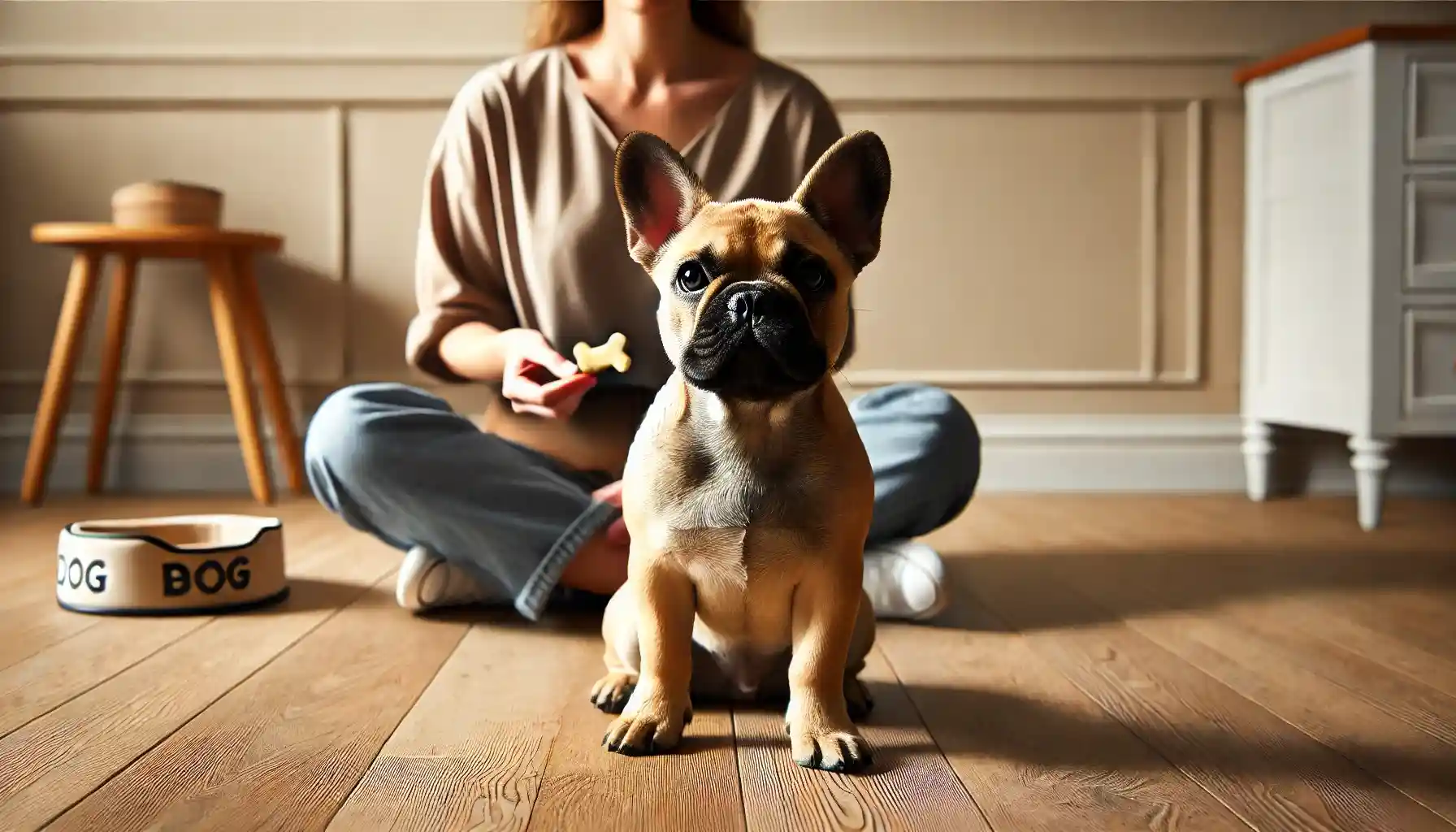
Factors Affecting French Bulldog Behavior
Several key factors influence a French Bulldog’s response to training:
- Health considerations: Their brachycephalic (flat-faced) structure can cause breathing difficulties that affect exercise tolerance during active training sessions. Effective French Bulldog training accounts for these physical limitations with appropriate activity levels and rest periods.
- Temperature sensitivity: French Bulldogs struggle to regulate body temperature efficiently, making them less responsive to training in hot or humid conditions. Schedule training sessions during cooler parts of the day for optimal results.
- Age-related factors: A French Bulldog puppy requires different training approaches than an adult dog. Puppies have shorter attention spans but fewer ingrained habits, while adult dogs may have established behaviors that require modification.
- Individual personality variations: While breed tendencies provide general guidelines, each French Bulldog has a unique personality that affects their training response. Some are naturally more compliant, while others show greater independence or sensitivity.
- Prior experiences: Previous training experiences, either positive or negative, significantly impact how a French Bulldog responds to new training efforts. Dogs with positive associations learn more quickly, while those with negative experiences may show resistance.
- Social environment: The household dynamic, including interactions with other pets and family members, influences behavioral patterns. Consistent expectations from all family members are crucial for effective French Bulldog training.
I’ve observed that many French Bulldog training challenges stem from owners not accommodating these unique factors. For example, one client struggled with seemingly stubborn behavior in their Frenchie until we identified that training sessions were scheduled during the hottest part of the day when the dog was physically uncomfortable and naturally less responsive.
Basic Training Techniques for French Bulldogs
Establishing a solid foundation is essential for successful French Bulldog training. These fundamental techniques set the stage for more advanced skills while building a positive relationship with your dog.
Puppy Training Basics for French Bulldogs
Starting French Bulldog training early yields the best results. For puppies, focus on these essentials:
- Establishing a routine: French Bulldogs thrive on predictability. Create a consistent daily schedule for feeding, potty breaks, training sessions, play, and rest to help your puppy understand expectations.
- Name recognition: Begin French Bulldog training by teaching your puppy to respond to their name. Say their name in an upbeat tone, and immediately reward eye contact with praise or a treat. Practice in progressively more distracting environments.
- Basic commands: Start with simple commands like “sit,” “stay,” and “come.” Keep training sessions brief (3-5 minutes) but frequent (several times daily) to accommodate puppy attention spans.
- Handling exercises: Incorporate gentle handling of paws, ears, mouth, and body during French Bulldog training to prepare your puppy for grooming, veterinary exams, and general care.
- Bite inhibition: French Bulldog puppies often explore with their mouths. Teach bite inhibition by immediately ending play when teeth touch skin, replacing hands with appropriate toys, and reinforcing gentle interactions.
- Crate training: Introduce a properly sized crate as a positive space for security and rest. Never use the crate as punishment during French Bulldog training, as this creates negative associations.
For one French Bulldog puppy I worked with, establishing a predictable routine reduced accidents by nearly 80% within just one week, demonstrating how strongly these dogs respond to consistency in their environment.
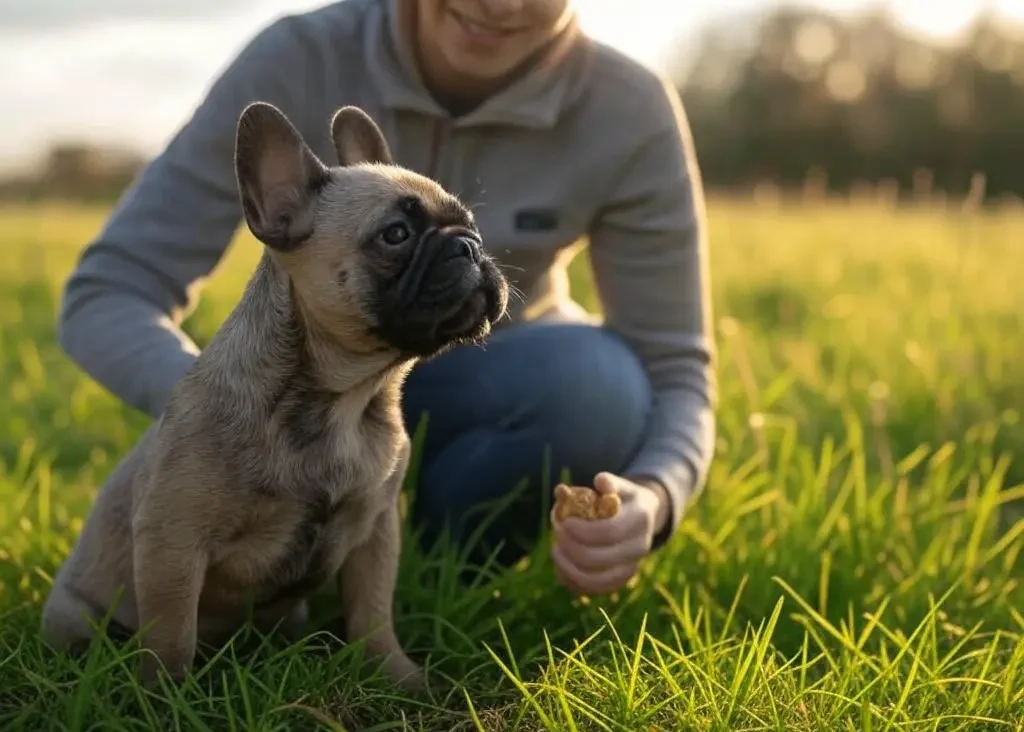
Leash Training for French Bulldogs
Proper leash manners are an essential component of French Bulldog training:
- Introduction to collar/harness: Begin by allowing your French Bulldog to wear their collar or harness for short periods during positive activities like meals or play before attaching a leash.
- Harness selection: Most French Bulldogs respond better to harnesses than collars for leash training, as harnesses distribute pressure more comfortably and protect their respiratory system.
- Indoor practice: Start French Bulldog training for leash skills indoors in a familiar, low-distraction environment before venturing outside where more stimuli exist.
- Reward positioning: Encourage proper leash walking by rewarding your French Bulldog when they’re in the desired position beside you, using frequent treats initially that gradually decrease as the behavior becomes established.
- Direction changes: Practice frequent changes in direction during leash training to teach your French Bulldog to pay attention to your movements rather than pulling toward their own interests.
- Loose leash reinforcement: Only move forward when the leash remains loose, stopping immediately when pulling occurs. This teaches your French Bulldog that pulling achieves the opposite of their desired outcome.
- Consistency factor: Ensure all family members use the same techniques during French Bulldog training for leash manners to prevent confusion and mixed messages.
For stubborn pullers, I often recommend starting with very short walks focused entirely on training proper leash manners before gradually increasing distance as skills improve.
Housebreaking Strategies for French Bulldogs
Housetraining is often cited as one of the more challenging aspects of French Bulldog training, requiring patience and consistency:
- Frequent opportunities: Take young French Bulldog puppies outside every 1-2 hours, after meals, naps, and play sessions to prevent accidents and create successful learning opportunities.
- Designated bathroom area: Choose a specific outdoor location for bathroom breaks to help your French Bulldog recognize appropriate elimination areas through consistent association.
- Reward timing: Provide immediate praise and rewards while your French Bulldog is eliminating in the correct location, not after returning inside when the connection may be less clear.
- Accident management: Clean accidents thoroughly with enzymatic cleaners to remove odors that might attract repeat incidents in the same location. Never punish accidents during French Bulldog training, as this can create negative associations with elimination in your presence.
- Overnight management: Restrict access to water 2-3 hours before bedtime for puppies, and use properly sized crates at night to leverage their natural instinct to avoid soiling their sleeping area.
- Consistent feeding schedule: Regular meal times lead to predictable elimination patterns, making housebreaking more manageable during French Bulldog training.
- Medical considerations: Rule out potential medical issues if a previously housetrained French Bulldog begins having accidents, as urinary tract infections and other conditions can affect bladder control.
One client struggled with a seemingly “untrainable” 8-month-old French Bulldog until we discovered the dog had been inadvertently trained to eliminate on puppy pads placed in multiple locations throughout the home. By gradually restricting pad locations and moving them progressively closer to the door before transitioning entirely outdoors, we successfully completed housetraining within three weeks.
Advanced Training Methods for French Bulldogs
Once your French Bulldog masters the basics, advanced training builds upon that foundation to develop a well-rounded canine companion with reliable behaviors in various situations.
Obedience Training for French Bulldogs
Structured obedience training enhances communication and reinforces your leadership role:
- Extended duration commands: Build upon basic training by gradually increasing the duration of “stay” and “wait” commands, adding controlled distractions to strengthen reliability during French Bulldog training.
- Distance work: Practice commands from progressively greater distances, teaching your French Bulldog to respond reliably even when you’re not immediately beside them.
- Multiple command sequences: String together several commands in sequence (e.g., “sit,” “stay,” “come,” “down”) to build cognitive skills and response flexibility.
- Reliability in various environments: Practice obedience in different locations with increasing levels of distraction to ensure your French Bulldog generalizes their training across contexts.
- Hand signals: Incorporate non-verbal cues alongside verbal commands during French Bulldog training, eventually allowing your dog to respond to either cue system independently.
- Proofing behaviors: Systematically introduce potential distractions (other dogs, people, sounds, movements) while practicing commands to build focus and reliability in real-world situations.
Advanced obedience provides mental stimulation that’s particularly beneficial for French Bulldogs, who can otherwise become bored and develop problematic behaviors. I recommend at least 10-15 minutes of obedience practice daily, even for well-trained adult dogs, to maintain skills and provide cognitive exercise.
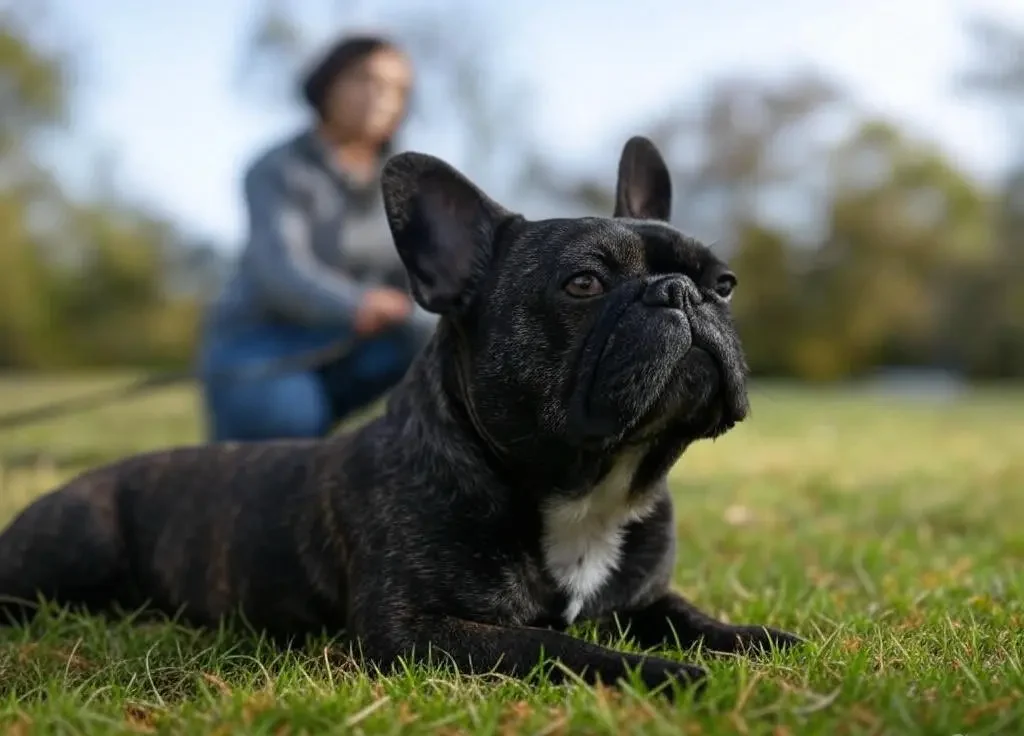
Socialization Techniques for French Bulldogs
Proper socialization creates confident, well-adjusted French Bulldogs capable of navigating various social situations:
- Critical period utilization: The window between 3-14 weeks represents the most critical socialization period. Early French Bulldog training should heavily emphasize positive exposure to various people, animals, environments, and experiences during this time.
- Controlled introductions: Arrange meetings with friendly, vaccinated dogs of various sizes and temperaments in neutral environments to develop appropriate canine social skills.
- People diversity: Expose your French Bulldog to people of different ages, appearances, and behaviors including those wearing hats, uniforms, using mobility devices, or carrying unusual objects.
- Environmental variety: Include exposure to different flooring surfaces, sounds, smells, and physical environments during French Bulldog training to build environmental confidence.
- Positive association building: Pair new experiences with high-value rewards to create positive emotional responses rather than simply exposing your dog to novel stimuli without support.
- Body language interpretation: Learn to recognize signs of stress, fear, or over-stimulation during socialization to prevent negative experiences that could undermine French Bulldog training goals.
- Ongoing socialization: Continue socialization efforts throughout your French Bulldog’s life, not just during puppyhood, to maintain social skills and adaptability.
For one anxious adult French Bulldog I worked with, we implemented a carefully structured counter-conditioning program that gradually transformed his fear-based reactivity toward strangers into neutral acceptance over approximately eight weeks of consistent practice.
Clicker Training for French Bulldogs
Clicker training provides precise communication that works exceptionally well for French Bulldog training:
- Marker association: Begin by establishing the clicker as a positive marker by clicking and immediately treating until your French Bulldog clearly anticipates a reward after hearing the click.
- Timing precision: Use the clicker to mark the exact moment your dog performs a desired behavior, providing clearer communication than verbal praise alone.
- Shaping behaviors: Clicker training excels at building complex behaviors through successive approximations, rewarding incremental steps toward the final desired behavior.
- Capturing natural behaviors: Use the clicker to mark and reinforce spontaneous behaviors you’d like to encourage or put on cue during French Bulldog training.
- Reducing treat dependency: The precise timing of the clicker allows for a gradual reduction in food rewards while maintaining strong behavioral responses.
- Problem-solving approach: For French Bulldogs who become frustrated easily, clicker training provides clear feedback that reduces confusion and builds confidence.
I’ve found clicker training particularly effective with French Bulldogs due to their intelligence and problem-solving nature. The clarity of communication reduces frustration and builds engagement in training sessions, especially for more complex behaviors.
Troubleshooting Training Issues in French Bulldogs
Even with proper techniques, French Bulldog training may encounter challenges. Understanding common issues and their solutions helps address problems effectively before they become established patterns.
Common Training Challenges with French Bulldogs
Several issues frequently arise during French Bulldog training:
- Stubborn refusal: Many French Bulldogs selectively ignore commands, especially if they find an alternative activity more rewarding. Increase the value of your training rewards and ensure training sessions remain engaging and varied.
- Short attention span: Maintaining focus can be difficult during French Bulldog training. Keep sessions brief (5-10 minutes), high-energy, and end on a successful note before your dog loses interest.
- Inconsistent response: French Bulldogs may perform well in training sessions but fail to generalize behaviors to other environments. Practice commands in multiple locations with gradually increasing distractions.
- Resource guarding: Some French Bulldogs develop protective behaviors around food, toys, or resting places. Address this early through systematic desensitization and counter-conditioning techniques.
- Demand behaviors: French Bulldogs often develop attention-seeking behaviors like barking or pawing. Consistently ignore these behaviors while rewarding calm alternatives during training.
- Heat sensitivity: Physical discomfort in warm conditions can appear as training resistance. Schedule French Bulldog training sessions during cooler times of day and watch for signs of overheating.
- Selective hearing: Many French Bulldogs respond inconsistently depending on competing motivations in the environment. Build value for responding to commands by using high-value rewards initially and practicing in progressively more challenging environments.
For example, a client’s French Bulldog would consistently perform commands at home but appeared “untrained” during walks. By gradually practicing in the front yard, then the sidewalk, and finally during actual walks with high-value rewards, we established reliable response in all environments.

Solutions for Aggression in French Bulldogs
While not generally aggressive, some French Bulldogs develop concerning behaviors that require specific training approaches:
- Resource guarding interventions: Teach your French Bulldog that people approaching their resources predicts additional rewards rather than loss through systematic counter-conditioning.
- Fear-based aggression management: Address underlying anxiety through desensitization protocols that gradually expose your dog to fear triggers at a level that doesn’t provoke reaction while building positive associations.
- Territorial behavior modification: Implement structured greeting routines and managed introductions that teach your French Bulldog appropriate behaviors when visitors enter your home.
- Defensive aggression protocols: For French Bulldogs who react aggressively when feeling cornered or restrained, implement handling exercises that build comfort with various types of touch and restraint.
- Professional assessment: Consult with a veterinary behaviorist or certified dog behavior consultant for French Bulldog training issues involving any concerning aggressive displays, as these behaviors can escalate if improperly addressed.
- Medical evaluation: Always rule out pain or medical causes when aggression appears suddenly in a previously non-aggressive French Bulldog.
- Management strategies: While working through a behavior modification plan, implement appropriate management tools like baby gates, crates, or muzzle training to prevent rehearsal of problematic behaviors.
For serious aggression cases, professional help is strongly recommended as part of comprehensive French Bulldog training. In one case I managed, what appeared to be aggression toward children was actually fear-based defensive behavior stemming from a previous negative experience. Through gradual positive exposure and counter-conditioning, we successfully resolved the issue over approximately three months.
Addressing Separation Anxiety in French Bulldogs
French Bulldogs form strong attachments to their owners, sometimes leading to separation-related issues:
- Independence building: Incorporate short separations into daily French Bulldog training routines, gradually increasing duration as your dog shows comfort with being alone.
- Departure cue desensitization: Practice picking up keys, putting on shoes, and other pre-departure activities without actually leaving to reduce anxiety triggers.
- Self-soothing development: Provide special toys or long-lasting treats exclusively during alone time to create positive associations with your absence.
- Gradual absence training: Systematically increase the duration of separations, starting with seconds and building to minutes, then hours, based on your French Bulldog’s comfort level.
- Anxiety signal monitoring: Learn to recognize early signs of separation distress during training so you can adjust the pace of your protocol accordingly.
- Environmental enrichment: Create a stimulating environment with puzzle toys, appropriate chewing items, and comfort objects to occupy your French Bulldog during alone time.
- Professional support consideration: For severe cases, consult with a veterinary behaviorist who may recommend behavioral medication alongside French Bulldog training protocols.
For one severe case of separation anxiety, we implemented a comprehensive protocol that included a camera to monitor progress, systematic desensitization to being alone, anti-anxiety medication prescribed by a veterinarian, and environmental modifications. Within six weeks, the dog could comfortably remain alone for four hours—a significant improvement from the initial 30 seconds of tolerance.
Importance of Consistency in Training French Bulldogs
Consistency provides the framework that makes all French Bulldog training techniques effective. Without it, even the best methods yield limited results.
Creating a Training Schedule for French Bulldogs
Strategic scheduling optimizes learning and reinforcement:
- Daily training blocks: Schedule 2-3 short (5-10 minute) focused French Bulldog training sessions daily rather than one longer session to maximize attention and retention.
- Pre-meal training: Conduct sessions before meals when food motivation is highest, particularly for food-motivated French Bulldogs.
- Energy level consideration: Schedule more active training when your French Bulldog’s energy is moderate—not when they’re extremely energetic or tired.
- Integration with daily activities: Incorporate command practice into regular daily activities like before meals, walks, or play sessions to reinforce that responses are expected in real-life situations, not just formal training.
- Weekly skill focus: Designate specific skills to focus on each week while maintaining previously learned behaviors through briefer practice sessions.
- Progress tracking: Keep a simple log of training achievements to monitor progress and identify areas needing additional attention in your French Bulldog training program.
- Consistency across caregivers: Ensure all family members understand and follow the same training protocols, cues, and reward systems to prevent confusion.
One family I worked with created a simple wall chart showing the weekly skill focus and daily training times, which significantly improved their French Bulldog’s progress by ensuring consistent practice from all family members.
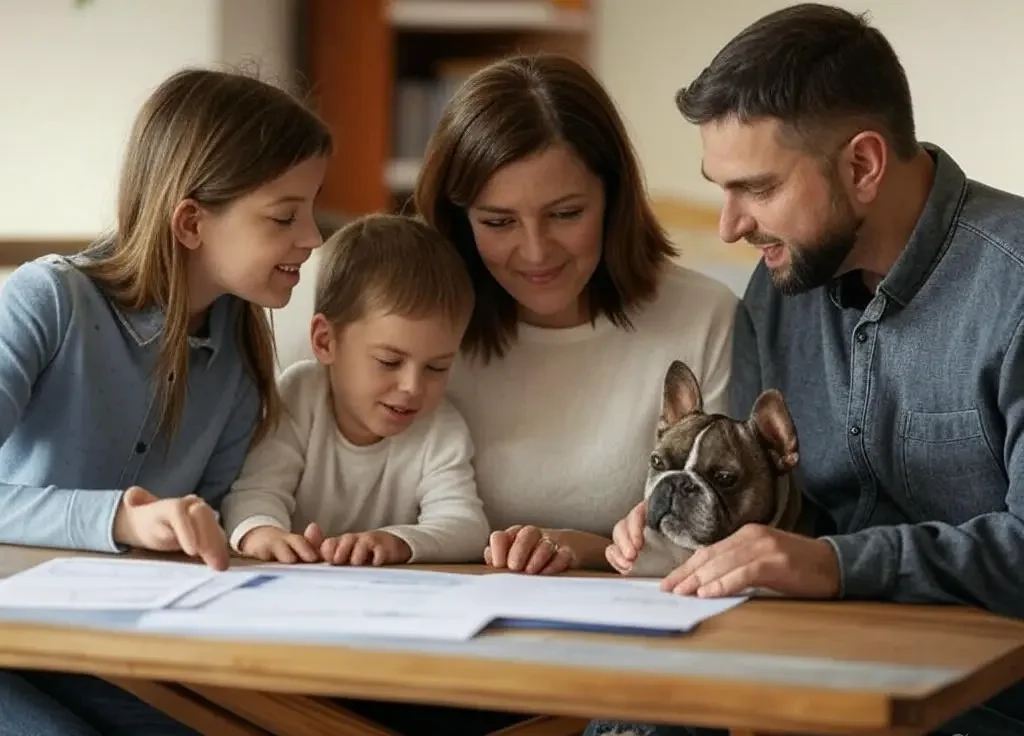
Reinforcement Techniques for French Bulldogs
Strategic reinforcement strengthens desired behaviors:
- Variable reward schedules: Once a behavior is established in French Bulldog training, transition from rewarding every correct response to intermittent reinforcement to strengthen the behavior’s resistance to extinction.
- Reward variety: Alternate between food treats, toy play, praise, and life rewards (like door openings or walk time) based on your French Bulldog’s individual motivations.
- Capturing everyday successes: Reward spontaneous good behavior outside formal training sessions to strengthen these behaviors in natural contexts.
- Jackpot rewards: Occasionally provide an unusually high-value or quantity of rewards for particularly good performance to increase motivation during French Bulldog training.
- Clear marker timing: Whether using a clicker or verbal marker like “yes,” ensure precise timing that clearly communicates exactly which behavior earned the reward.
- Decreasing reward dependency: Gradually reduce reliance on treats by incorporating more praise, life rewards, and intermittent reinforcement as behaviors become reliable.
- Negative punishment appropriate use: When necessary, employ the temporary removal of something your French Bulldog values (attention, play, freedom) rather than applying aversive stimuli to decrease unwanted behaviors.
One French Bulldog I worked with responded minimally to food rewards but was highly motivated by brief play sessions with a specific toy. By reserving this toy exclusively for training rewards, his owner achieved breakthrough progress in previously challenging behaviors.
Comparing Training Tools and Techniques for French Bulldogs
Different approaches to French Bulldog training offer varying advantages. Understanding these differences helps you select methods that best suit your individual dog.
Positive Reinforcement vs. Negative Reinforcement in French Bulldog Training
Training methodologies produce different results and side effects:
- Positive reinforcement effectiveness: Rewarding desired behaviors with things your French Bulldog values (treats, play, praise) builds confidence and enthusiasm for training. This approach is particularly effective with sensitive breeds like French Bulldogs.
- Negative reinforcement limitations: Methods that apply unpleasant stimuli until the dog performs the desired behavior may produce compliance but often create stress and damage the human-animal bond during French Bulldog training.
- Scientific support comparison: Contemporary behavioral science strongly supports positive reinforcement as more effective and less likely to produce behavioral fallout than methods based on aversive stimuli.
- Learning environment differences: Positive methods create an environment where French Bulldogs feel safe to offer behaviors without fear of making mistakes, enhancing creativity and problem-solving.
- Long-term reliability factors: Behaviors taught through positive reinforcement during French Bulldog training tend to be more resilient over time compared to those maintained through aversive consequences.
- Relationship impact: Positive reinforcement builds trust and strengthens your bond, while punishment-based methods can create anxiety and conflicted feelings toward the handler.
- Breed-specific considerations: French Bulldogs’ sensitive temperament makes them particularly responsive to positive methods and potentially more damaged by aversive techniques than some other breeds.
Throughout my career, I’ve worked with numerous French Bulldogs who developed fear or aggression issues after exposure to punishment-based training, requiring extensive rehabilitation to restore confidence and trust.
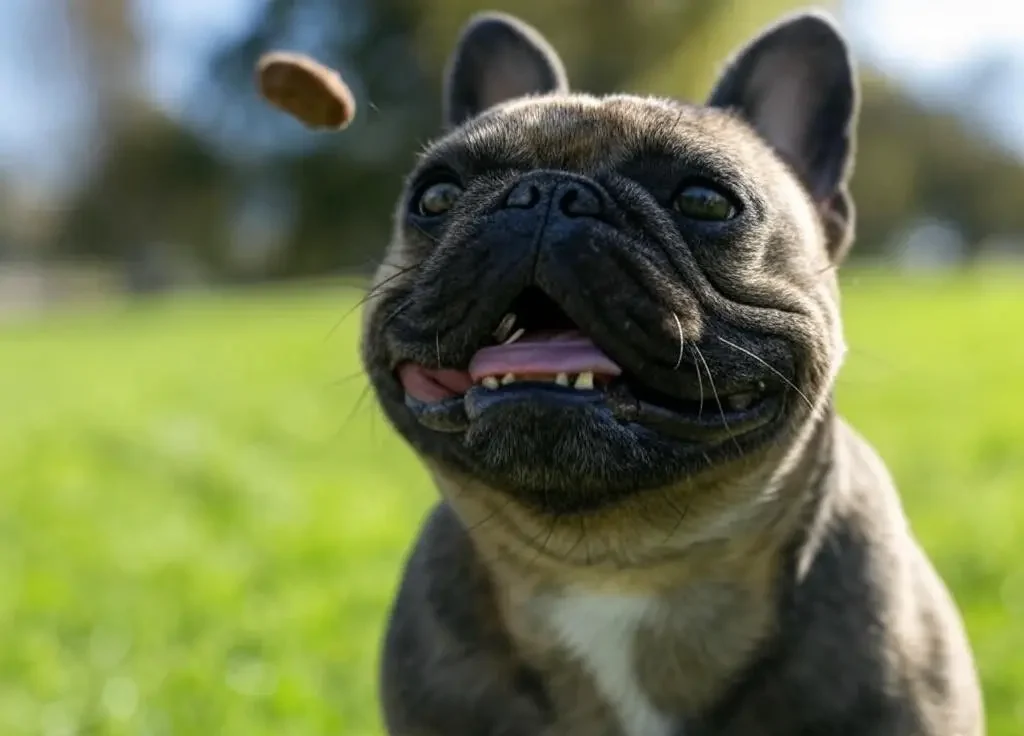
Using Treats vs. Toys as Rewards in Training
Different reward systems offer unique advantages in French Bulldog training:
- Food reward advantages: Treats can be delivered quickly and precisely, allowing for rapid repetition during training. They’re often highly motivating for French Bulldogs and can be easily varied in value by using different types.
- Toy reward benefits: Play rewards incorporate physical activity and bonding into training sessions. They can be less likely to cause weight gain and may create more enthusiasm in play-motivated French Bulldogs.
- Individual preference consideration: Some French Bulldogs respond more strongly to food, while others prefer toy play or social rewards. Identifying your dog’s strongest motivators enhances training effectiveness.
- Practical application differences: Food rewards work well for precise behaviors or calm responses, while toy rewards excel for building enthusiasm in recall or agility-related French Bulldog training.
- Transitioning between reward types: Start with whatever motivates your French Bulldog most strongly, then gradually introduce variety to prevent dependence on a single reward type.
- Health considerations: For French Bulldogs with food sensitivities or weight management needs, toy or social rewards may be preferable for regular training.
- Context appropriateness: Different environments and training goals may call for different reward types during French Bulldog training.
One creative solution I developed for a food-motivated French Bulldog on a restricted diet was using his regular kibble, slightly moistened and warmed, as training treats. By measuring his daily food allowance and using portions during training, we maintained his weight while still providing motivating rewards.
Engaging Activities to Enhance Training for French Bulldogs
Supplementary activities reinforce training while providing mental and physical exercise that prevents boredom-related behavior problems.
Mental Stimulation Activities for French Bulldogs
Cognitive challenges are essential for this intelligent breed:
- Puzzle toys: Food-dispensing puzzles require problem-solving skills that engage your French Bulldog’s mind. Gradually increase difficulty as your dog masters simpler puzzles.
- Scent work introduction: Hide treats or toys around your home and encourage your French Bulldog to find them, gradually increasing difficulty by expanding the search area or using more challenging hiding spots.
- Training circuits: Create a sequence of previously learned commands for your French Bulldog to perform, adding complexity over time.
- New skill introduction: Regularly introduce new behaviors to keep French Bulldog training sessions fresh and engaging.
- Object discrimination: Teach your French Bulldog to distinguish between different named toys, gradually increasing the number of items they can identify.
- Interactive toys: Provide toys that respond to your dog’s actions with movement, sounds, or treat dispensing to encourage engagement.
- Environmental enrichment rotation: Regularly rotate toys and enrichment activities to prevent habituation and maintain interest.
For one apartment-dwelling French Bulldog with excess energy, we created an indoor “treasure hunt” where meals were divided into multiple puzzle toys hidden throughout the home. This simple activity provided physical exercise, mental stimulation, and reinforcement of training skills simultaneously.
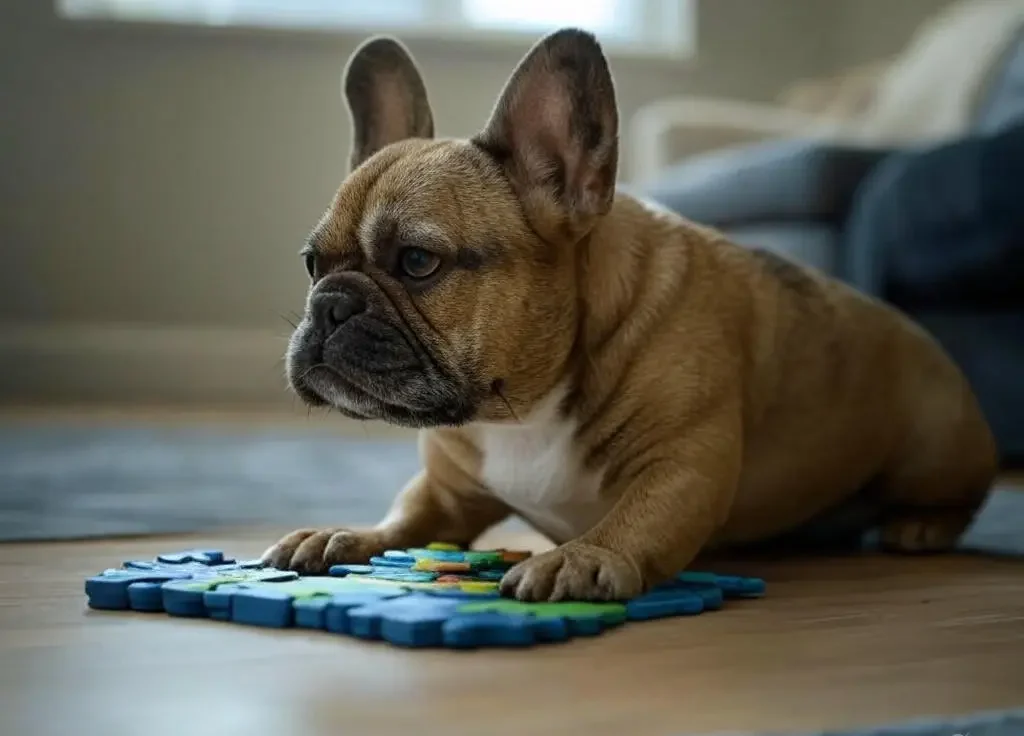
Fun Tricks to Teach Your French Bulldog
Trick training combines entertainment value with practical skill development:
- “Spin” and “Twist”: Teaching your French Bulldog to turn in circles in both directions improves body awareness and responsiveness to directional cues.
- “High Five” or “Shake”: This crowd-pleasing trick reinforces paw control while strengthening the human-animal bond during French Bulldog training.
- “Play Dead”: This trick builds duration control and body position awareness while entertaining friends and family.
- “Find It”: Teaching your French Bulldog to locate specific toys by name combines scent work with object discrimination for excellent mental exercise.
- “Back Up”: This practical skill helps with spatial awareness and has useful real-world applications.
- “Middle”: Training your French Bulldog to position themselves between your legs provides a safe position in crowded environments and builds positional awareness.
- “Leave It” with balancing: Advancing the basic “leave it” command to include balancing treats on your dog’s nose or paws builds impressive impulse control.
Trick training sessions should remain lighthearted and fun, ending before your French Bulldog loses interest. These activities build a positive association with training while developing skills that transfer to more practical behaviors.
Resources for French Bulldog Training
Expanding your knowledge through quality resources enhances your ability to effectively train your French Bulldog.
Recommended Books and Guides for French Bulldog Training
These authoritative resources provide valuable information:
- “Culture Clash” by Jean Donaldson: Offers fundamental understanding of dog cognition and learning principles applicable to French Bulldog training.
- “Don’t Shoot the Dog” by Karen Pryor: Explains positive reinforcement principles in accessible language with practical applications.
- “The Power of Positive Dog Training” by Pat Miller: Provides a comprehensive system for force-free training that works well with sensitive breeds like French Bulldogs.
- “Decoding Your Dog” by American College of Veterinary Behaviorists: Offers science-based insights into understanding and modifying dog behavior.
- “Brachycephalic Breed Training Manual” by Dr. Sophia Wells: Specifically addresses training considerations for flat-faced breeds like French Bulldogs.
- “Fired Up, Frantic, and Freaked Out” by Laura VanArendonk Baugh: Excellent resource for French Bulldog training with anxious or reactive dogs.
- “Behavior Adjustment Training 2.0” by Grisha Stewart: Provides strategies for managing reactivity that may appear during French Bulldog training.
These books complement hands-on experience by providing theoretical frameworks and specific techniques tailored to different training challenges.
Online Courses and Videos for French Bulldog Owners
Digital resources offer flexible learning opportunities:
- Certified online training academies: Platforms like the Karen Pryor Academy and E-Training for Dogs offer structured courses with professional guidance.
- Breed-specific webinars: Look for online seminars addressing the specific needs and challenges of brachycephalic breeds.
- Training apps: Applications like “Dogo” or “Puppr” provide step-by-step guidance for teaching various skills during French Bulldog training.
- Professional trainer channels: Several certified professional trainers maintain YouTube channels with free training demonstrations and advice.
- French Bulldog training forums: Online communities dedicated to the breed offer peer support and shared experiences.
- Virtual consultations: Many professional trainers now offer remote sessions via video calls, providing personalized guidance for French Bulldog training challenges.
- Professional organizations: Websites for organizations like the Association of Professional Dog Trainers (APDT) offer resources and trainer directories.
When evaluating online resources, prioritize those created by trainers with verifiable credentials who emphasize humane, science-based methods compatible with your French Bulldog’s sensitive nature.
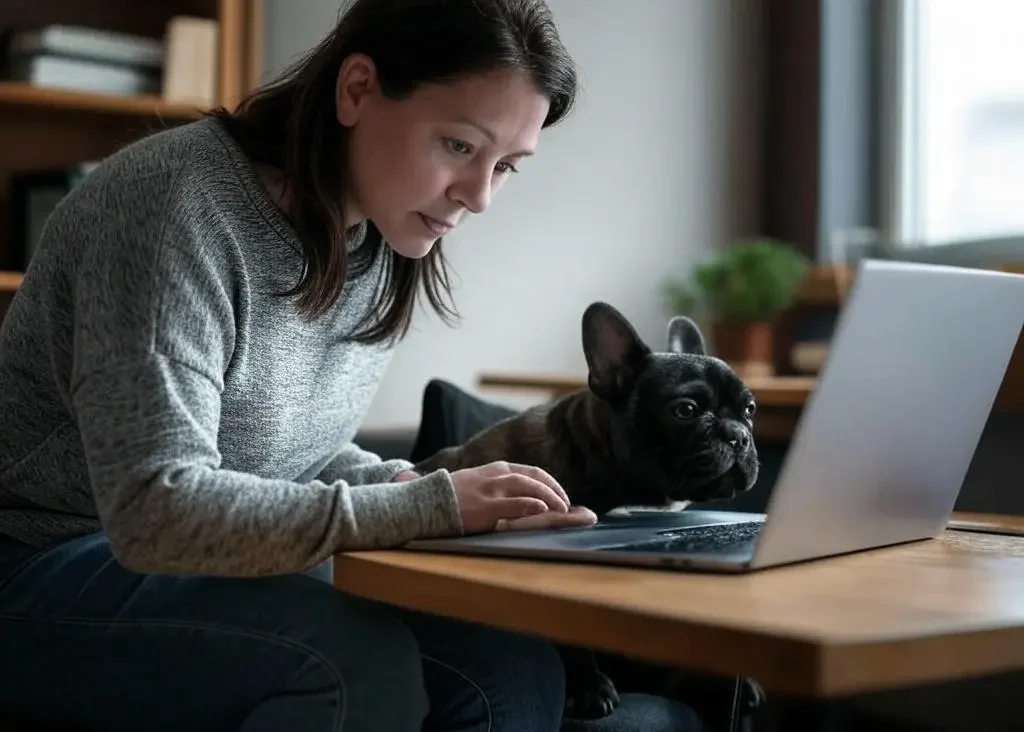
Conclusion: Building a Lifetime of Good Behavior
Effective French Bulldog training creates a foundation for a harmonious relationship between you and your dog. By understanding their unique temperament, applying consistent positive methods, and addressing challenges proactively, you’ll develop a well-behaved companion who responds reliably to guidance.
Remember that training is an ongoing process rather than a destination. Even well-trained French Bulldogs benefit from continued mental stimulation, skills practice, and positive reinforcement throughout their lives. View training as a way to communicate with your dog and strengthen your bond rather than simply a means of controlling behavior.
With patience, consistency, and the right techniques, your French Bulldog can become a well-mannered, confident companion who brings joy to your life while navigating the human world with ease and good manners.
FAQs About French Bulldog Training
At what age should I start training my French Bulldog?
Begin French Bulldog training immediately when you bring your puppy home (around 8 weeks). Focus on socialization, basic commands, and house training using positive methods. Early training is crucial as the critical socialization period ends at approximately 14 weeks of age.
Are French Bulldogs harder to train than other breeds?
French Bulldogs can be moderately challenging to train due to their independent nature and occasional stubbornness. However, they’re intelligent and responsive to positive reinforcement. Effective French Bulldog training requires high-value rewards, short sessions, and consistency rather than punishment-based methods. Most Frenchies excel with patient guidance.
How do I stop my French Bulldog from chewing furniture?
Provide appropriate chew toys, apply bitter apple spray on forbidden items, ensure adequate exercise, and supervise until good habits form. When inappropriate chewing occurs, redirect to acceptable items rather than punishing. Most French Bulldog training for chewing issues resolves with consistent management and proper alternatives.
Why does my French Bulldog ignore commands outside our home?
Dogs don’t automatically generalize behaviors across environments. Practice French Bulldog training in different locations with gradually increasing distractions. Start in low-distraction areas, use higher-value rewards, and systematically work in various settings until your Frenchie responds reliably everywhere. This environmental generalization is essential for reliable obedience.
How long does it take to fully train a French Bulldog?
Basic French Bulldog training typically takes 4-6 months with consistent practice, while advanced reliability requires ongoing reinforcement. Training is a continuous process throughout your dog’s life rather than a finite task. Regular practice maintains skills and provides essential mental stimulation.

